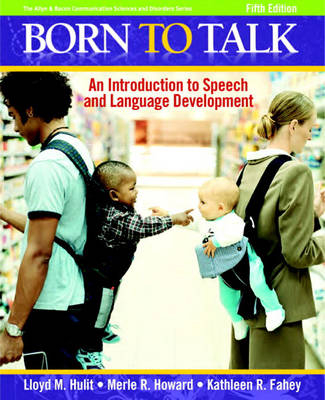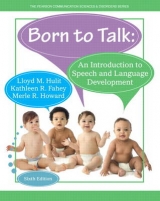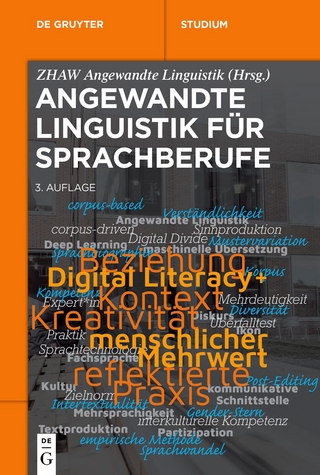
Born to Talk
Pearson (Verlag)
978-0-205-62752-3 (ISBN)
- Titel erscheint in neuer Auflage
- Artikel merken
The new revised fifth edition of Born To Talk includes up-to-date research on the impact of parent-child interactions, language samples from one child across the first three years, and emergent literacy in preschool. The revision also expands on the acquisition of the sound system and brings an integrated perspective of childhood language disorders through case examples.
New research is covered throughout the book regarding the impact of parent-child interactions, language samples from one child across the first three years, and emergent literacy in preschool.
An expanded section on the acquisition of the sound system helps readers better understand a vital aspect of language development.
New case studies found throughout the text provide students with real-life examples of childhood language disorders.
"I was thrilled to find Born to Talk to use as a text for my undergraduate language acquisition course and as a supplement for my graduate early literacy course. The book is challenging for students, but as scholarly as it is, it is also interesting and makes the study of language acquisition come alive for the students." Margaret Coxwell, Minot State University
Preface
Chapter 1
A Connection of Brains
Separate but Related Processes
Characteristics of Human Speech
Speech: The Tale of Two Brains
Websites to Explore
Review Questions
References and Suggested Readings
Chapter 2
Language Acquisition: A Theoretical Journey
Evidence of Biology and Environment on Language-Learning
A Review: The Major Theories of Language Acquisition
The Behaviorist Interpretation: The Role of Nurturing — The Extreme View of Environmental Contributions to Language Development
Nativist Interpretation: The Role of Biology —The Extreme View Nature’s Contributions to Language Development
Interactionist Interpretations
Piaget’s Cognitive Theory
Information Processing Theory/Competition Model
Social Interactionist View
Speech Act Theory: A Focus on Pragmatics
Emergentist Perspective: A New View
Websites to Explore
Review Questions
References and Suggested Readings
Chapter 3
Cognitive Development: Building a Foundation for Language
Piaget’s Theory of Cognitive Development
Vygotsky’s Theory of Cognitive Development: A Sociocultural Perspective
Dynamic Systems Theory
The Perceptual Groundwork for Communication
Websites to Explore
Review Questions
References and Suggested Readings
Chapter 4
In the Beginning: Communication Development from Birth to Two Years
From the Beginning: The Infant Communicates
The Role of Social Contingency and Joint Attention/Reference in Communication
Ready to Receive Language — Perception and Comprehension of Words
Ready to Speak — Expressive Growth in Infancy
The Development of Communication Functions: Using Communication to Get Things Done
Beyond Infancy: The Emergence of Language
Syntactic Development: From Words to Word Combinations
Comprehension and Production: A Critical and Evolving Relationship
The Role of the Caregiver in the Acquisition of Early Language
Stage 1: A Brief Look Back and a Glimpse Forward
Websites to Explore
Review Questions
References and Suggested Readings
Chapter 5
The Saga Continues: Language Development through the Preschool Years
Stage 2: Elaborating Structure and Refining Meaning
Stage 3: Producing Longer, More Adultlike Sentences
Stage 4: Elaboration with Phrases and Clauses
Stage 5. Polishing the Act
The Role of Comprehension and Production in the Development of Language
Websites to Explore
References and Suggested Readings
Chapter 6
Taking Language to School and into Adulthood
Semantic Development
Syntax and Morphology
Pragmatics, Conversation, and Narratives
Metalinguistic Development
Learning to Read and Write
Language into Adulthood
Websites to Exlore
Review Questions
References and Suggested Readings
Chapter 7
The Building Blocks of Speech
Describing Speech Sounds
Early Development of Sounds for Speech
Later Development of Speech Sounds
Co-Articulation and Suprasegmental Aspects of Speech Production
The Roles of Biology, Cognition, and Social Interaction in Phonological Development
Websites to Explore
Review Questions
References and Suggested Readings
Chapter 8
Language Diversity and Bilingual Language Development
Dialects and Accents
Regional Dialects
Social/Cutural Dialects
The Changing Face of America and Bilingual Language Development
Simultaneous and Successive Language Acquisition
Cognition, Language, and Literacy Development
The Optimal Age of Second Language Learning
A Closer Look at Simultaneous Bilingualism
A Closer Look at Successive or Sequential Bilingualism
Stages of Language Development in Bilingual Children
Bilingualism: Good, Bad, or Inevitable?
Curricular Approaches, Teacher Preparation, and Classroom Environment
Websites to Explore
Review Questions
References and Suggested Readings
Chapter 9
Speech and Language Disorders in Home, School, and Community
Causes of Communication Disorders
Characteristics of Speech and Language Disorders
Four Students with Speech, Language, and Learning Problems
Voice Disorders
Fluency Disorders
Websites to Explore
References and Suggested Readings
Appendix
The Anatomical and Physiological Bases of Speech, Language, and Hearing
Speech as the Product of Borrowed Structures
The Four Processes of Speech
Respiration
Phonation
Resonation
Articulation
The Four Processes in Review
The Brain: The Computer Center for Speech and Language
The Ear: An Energy Transformer
The Complete Speech and Language Machine
Review Questions
References and Suggested Readings
Name Index
Subject Index
| Erscheint lt. Verlag | 21.5.2010 |
|---|---|
| Sprache | englisch |
| Maße | 187 x 232 mm |
| Gewicht | 558 g |
| Themenwelt | Geisteswissenschaften ► Sprach- / Literaturwissenschaft ► Sprachwissenschaft |
| Medizin / Pharmazie ► Gesundheitsfachberufe ► Logopädie | |
| ISBN-10 | 0-205-62752-8 / 0205627528 |
| ISBN-13 | 978-0-205-62752-3 / 9780205627523 |
| Zustand | Neuware |
| Informationen gemäß Produktsicherheitsverordnung (GPSR) | |
| Haben Sie eine Frage zum Produkt? |
aus dem Bereich



